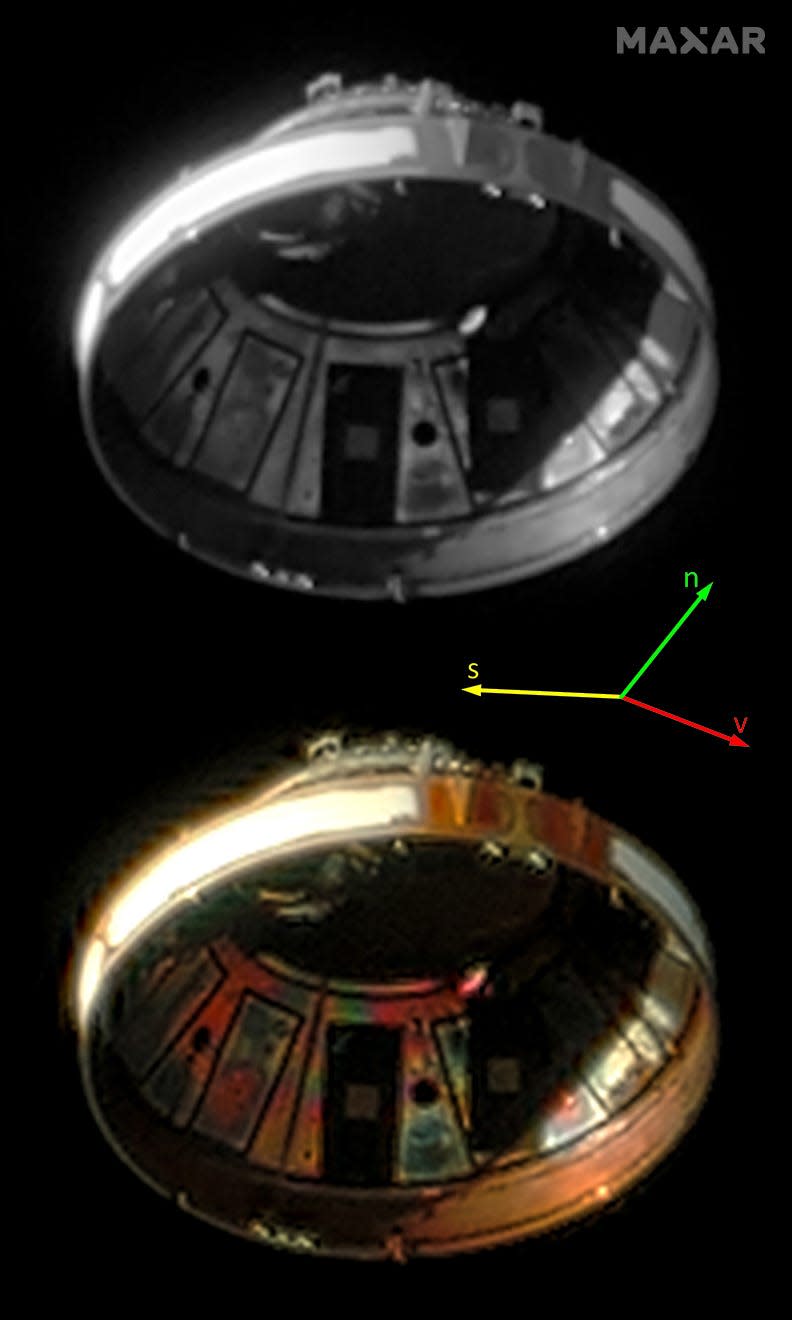A Russian 'inspector' satellite appears to be chasing a secret US military satellite in a game of cat and mouse
A Russian satellite appears to be stalking a classified US military satellite in a cat-and-mouse chase.
A series of Russian satellites that appear to be "inspectors" are passing close to targets in orbit.
See how much detail an inspector satellite could get on an adversary spacecraft in an image below.
A mysterious Russian satellite and a confidential US military satellite appear to be engaged in a cat-and-mouse chase through space.
The Russian spacecraft, called Kosmos-2558, was launched into the same orbital plane as the US satellite, called USA-326, in August 2022 and has regularly passed close to the American spacecraft ever since.
The behavior of Kosmos-2558, and the lack of a formal explanation from Russia, has led space observers to believe that the probe is stalking USA-326. It's at least the third satellite Russia has launched that appears to be an "inspector" — a spacecraft aiming to gather up-close data on another satellite.
The image below shows just how much detail an inspector satellite might be able to capture when photographing its target. A Maxar satellite, which usually images Earth, took this photo as it flew past a discarded piece of a Japanese rocket in orbit:

"That's just amazing," Jonathan McDowell, a Harvard astrophysicist, told Insider about the Maxar image. "And that's for a satellite that's not designed to look at other satellites. It was designed to look at the Earth."
If Kosmos-2558 is the inspector it seems to be, designed specifically to stalk and probably gather data on USA-326, then it's probably getting even better imagery.
Spacecraft have spied on each other for decades. All you have to do is launch your satellite into a higher orbit than the satellites you want to observe. But Russia appears to be trying a new method of stalking particular targets, and it's not clear why.
"That's really irresponsible behavior," Gen. James H. Dickinson, commander of US Space Command, told NBC News after Russia launched Kosmos-2558. "We see that it's in a similar orbit to one of our high-value assets for the US government."
The Pentagon has said that USA-326 is meant to support "overhead reconnaissance" — a spy satellite program for gathering intelligence by observing Earth.
Dickinson added that the US would continue to track the Russian spacecraft.
How one satellite can stalk another

The two satellites are orbiting Earth in the same plane, but at different speeds, allowing Kosmos-2558 to regularly pass beneath its US target.
"If you imagine two athletes running around a track on slightly different lanes of the track, and one's faster than the other, every now and again one laps the other and passes close," McDowell explained.
Each lap could be an opportunity to snap a photo.
According to McDowell's observations, Kosmos-2558 made four close passes at USA-326 in March. The Russian satellite usually passes within about 50 kilometers (31 miles) of its American target — not nearly close enough to risk a collision, but close enough to probably get detailed imagery.
"I see it as nosy rather than aggressive," McDowell said.
Russia seems to be experimenting with new space stalking technology
Russia has done this before.

Another Kosmos satellite displayed "stalking" behavior after its launch in 2014 — but it was stalking its own rocket stage, not an adversary spacecraft, according to reporting by Anatoly Zak, a journalist who covers Russia's space program and runs RussianSpaceWeb.com.
Then, in 2020, a US Space Force general reported that two mysterious Russian satellites were tailing a US spy satellite.
"It seems to be a program that they're experimenting with this technology," McDowell said.
The US satellite just pushed itself a bit higher
In the latest development of this game of orbital hide-and-seek, the US satellite jumped to a higher orbit, climbing farther away just before Kosmos-2558 was set to pass close by again on April 7, according to hobby satellite tracker Nico Janssen.
The Russian satellite was set to pass its US military target at a distance of about 31 kilometers on April 7, Janssen calculated. Instead, the closest it could get was 45 kilometers.
This could have been a maneuver the US conducted to evade the close approach of the Russian satellite, Zak reported. But it's not clear that the US satellite was running away.
"That would have been useless, since the Kosmos satellite can also increase its altitude again, if it wishes," Janssen told Insider in an email.
McDowell agrees.
"It's *possible* this was an evasive burn but not *likely* in my current opinion," he said in a follow-up email.
Instead, Janssen thinks the US satellite was just performing a routine boost to make up for the altitude it lost recently due to solar activity. Eruptions on the sun have sent charged particles washing over Earth, which can push satellites into lower orbits.
Between the sun and orbital spies, "satellites are very vulnerable," Janssen said.
Read the original article on Business Insider


